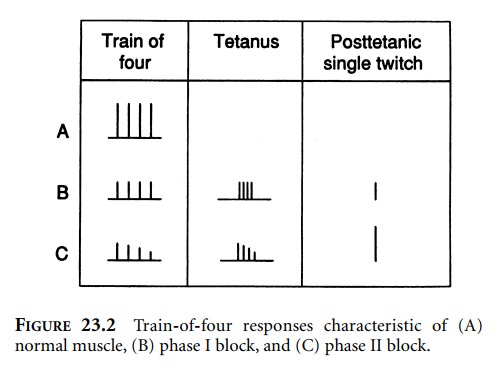Chapter: Clinical Cases in Anesthesia : Depolarizing Neuromuscular Blockade
Describe a phase II block
Describe a phase II block.
When succinylcholine is given to a patient for
a pro-longed period of time or in large doses, the nature of the block appears
to change. The second form of block is referred to as a phase II,
desensitization, or dual block. The recovery from succinylcholine in this
circumstance generally is prolonged, and the character of the block is altered.
Repeat nerve stimulation (train-of-four) following exposure to suc-cinylcholine
results in muscular response that is unchanged with repeated stimulation (no
fade or decrement of response), and no fade occurs with tetanic stimulation
(Figure 23.2). When a phase II block develops, fade is evident on train-of-four
stimulation (T4/T1 less than 50%) and on tetanic stimulation. Post-tetanic
potentiation may also be present. These patterns of response are typical of
non-depolarizing muscle relaxants, not depolarizing drugs such as
succinylcholine. The appearance of this block is related to the time and dose
of succinylcholine administration. Reports of phase II blocks have been
associated with 2–10 mg/kg administered over 1 hour. The onset may be
accel-erated by inhalation anesthetics.

Proposed mechanisms for phase II blockade
include channel blockade of the receptor by succinylcholine, desen-sitization
of the receptor in the presence of excessive ago-nists, and persistent ion flux
causing distortion of the junctional membrane. Channel blockade refers to the interference with ion movements
through the activated receptor by an obstructing molecule such as
succinylcholine. When a receptor remains open (activated) for a prolonged
period of time, such as during succinylcholine infusions, a molecule is more
likely to enter the channel of the receptor and obstruct ion movements.
Receptors are known to exist in at least three states: activated, receptive,
and desensitized. The desensitized receptor is unable to respond to an agonist,
even though the agonist may bind to the receptor. Prolonged agonist activity is
thought to predispose to an increase in receptors in the desensitized state. If
enough receptors are desensitized or have their channels blocked, they can no
longer participate in the maintenance of endplate depolar-ization, which is
responsible for succinylcholine’s neuro-muscular blockade.
Patients with atypical plasma cholinesterase
are more likely to develop phase II blockade. This may be the result of
excessive amounts of succinylcholine reaching the receptor and not being
rapidly metabolized in the plasma before it reaches the neuromuscular junction.
During the transition from phase I to phase II, a period of tachyphylaxis to
succinylcholine has been noted by some authors.
Related Topics